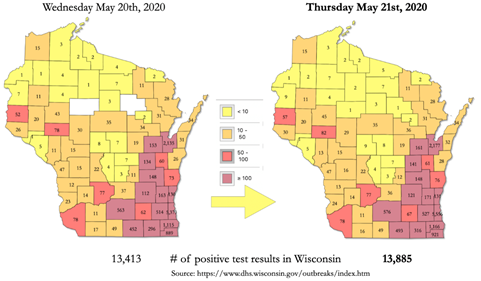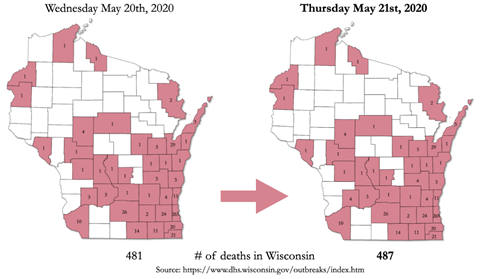Georgia
As of May 22nd
- Georgia Daily State Public Health Stats (Updated 5.22.20 at 1 p.m. ET)
- 41,218 confirmed cases as compared to 41,127 at 9 a.m. today
- 7,313 hospitalized patients as compared to 7,294 at 9 a.m. today
- 1,785 deaths as compared to 1,783 at 9 a.m. today.
- Over 427,249 tests have been administered.
- The GHSA Board of Trustees has approved a June 8th restart date for football activities one week later than first proposed. Football activities will be weight room plus conditioning only and for groups no larger than 20 including coaches.
Kansas
As of May 22nd
On Friday, May 22, at 7:54 AM, the Kansas Legislature concluded its 2020 Legislative Session. Like most legislative sessions across the country, the work done in Kansas was significantly disrupted by the COVID-19 pandemic. Specifically, most of the bills that lawmakers had worked on since January died during the legislative process because the number of days lawmakers had to work were significantly reduced.
Legislative leadership voted to return to Topeka on Thursday, May 21. This day was designated as “Sine Die” or the last day of the Legislative Session. Typically, Sine Die is ceremonial in nature and little business is addressed. This year, however, lawmakers decided they would finish all remaining items on that day. And, although there appeared to be mixed interpretations of legislative rules by lawmakers and staff, the general consensus was that all business for the Session must be finished by midnight on Sine Die (Thursday) or it would risk being declared unconstitutional. Due to delays in debate, the large number of items that were scheduled to be addressed in one day, as well as a multitude of other reasons, lawmakers did not finish their work on Thursday, but rather passed most of their bills Friday morning. Thus, any act passed on Friday could potentially be at risk of becoming null and void.
New Jersey
As of May 21st
The Governor of the State of New Jersey has published an executive order, directing that certain recreational businesses or activities that were closed by paragraph 9 of Executive Order No. 107 (2020) are permitted to reopen to the public or their members, with conditions.
North Carolina
As of May 20th
- Laboratory confirmed Coronavirus cases: 20,122
- Coronavirus deaths: 699
- Currently hospitalized: 554
- Completed tests: 277,603
- Number recovered: 11,000+
- NC Counties affected: 100/100
- Updated COVID-19 Dashboard (NC DHHS)
Highlights
It took eight weeks for North Carolina to record its first 10,000 infections; however, going from 10,000 to 20,000 took only three weeks.
The North Carolina Department of Health and Human Services unveiled an updated COVID-19 Dashboard. The interactive dashboard provides an overview on the metrics and capacities that the state is following to inform decisions to responsibly ease measures that slow the spread of the virus.
New modeling from a group of researchers at the University of Washington has significantly cut the number of COVID-19 deaths expected in North Carolina through August.
Governor Cooper announced Wednesday that the state will move to Phase 2 reopening beginning at 5:00 pm on Friday, May 22 and lasting until June 26.
- Executive Order 140, Extending Certain Transportation Related Provisions in Previous EOs, May 18
- Executive Order 141, Easing Restrictions on Travel, Business Operations and Mass Gatherings, May 20
Update
Governor Cooper announced today that the state will be moving to Phase 2 of the reopening plan beginning on Friday, May 22. The Governor described the next phase as a “more modest step forward than originally envisioned” and referred to the plan as “safer at home”. Phase 2 reopening continues the recommendation for teleworking and includes reduced capacity openings for dine-in at restaurants; personal care businesses such as barbershops and nail salons; swimming pools; and overnight and day camps. Childcare centers will be allowed to open at full capacity. The following businesses are not allowed to open during Phase 2: bars, nightclubs, gyms and indoor fitness facilities, indoor entertainment venues such as concert and event venues and public playgrounds. Mass gathering limits will be 25 or less at outdoor venues and 10 or less at indoor venues. Outdoor mass gathering requirements apply to parks, beaches, stadiums, etc. The Governor said that local governments may enforce more stringent requirements than the state order. The Governor also stated that Phase 2 will boost North Carolina’s economy, but only if citizens have confidence in their own safety.
While the state reported sharp increases in deaths and hospitalizations due to COVID-19 on Tuesday, the Secretary of NC DHHS said that the overall trends are stable enough to remove social restrictions on Friday. Dr. Mandy Cohen stated, “As we look at North Carolina’s numbers, we see them remain stable. We believe we can move forward to easing restrictions.”
New modeling from a group of researchers at the University of Washington has significantly cut the number of COVID-19 deaths expected in North Carolina through August. Projections from the Institute for Health Metrics and Evaluation now forecast 2,500 deaths from the disease through August 4. This projection is down about 40 percent from the group’s projection last week of 4,400 deaths. Daily deaths are still expected to peak in mid- to late-June, but at a lower rate of nearly 30 a day.
Executive Actions, Week of May 18th
- Executive Order 140, Extending Certain Transportation Related Provisions in Previous EOs, May 18
- Executive Order 141, Easing Restrictions on Travel, Business Operations and Mass Gatherings, May 20
COVID-19 Laws
- S 704 COVID-19 Recovery Act (S.L. 2020-3)
- H 1043 2020 COVID-19 Recovery Act (S.L. 2020-4)
Relevant Articles
Wisconsin
As of May 21st
Updated numbers released on Thursday:
The Wisconsin Department of Health Services and the Wisconsin Hospital Association released updated numbers on Thursday:
- 398 Current Hospital Admissions (126 patients in ICU)
- The total number of hospital admissions increased by 5 (+5) on Thursday
- +3 in SE WI, +2 Fox Valley, +2 SC WI, +1 NE WI and -1 in NC WI, -1 NW WI and -1 Western WI
- The total number of ICU patients decreased by 2 (-2) on Thursday
- -1 in NE WI, -1 in Fox Valley and -1 in SE WI, and +1 in CE WI
- The total number of hospital admissions increased by 5 (+5) on Thursday
- Cumulatively there have been 13,885 positive tests and 163,238 negative tests in Wisconsin:
- There were 472 positive test results reported on Thursday on 9,410 tests (5% positive rate).
- Deaths from COVID-19 now total 487 in Wisconsin:
- There were 6 deaths reported on Thursday
- 7,728 patients who have tested positive for COVID-19 and are listed as having recovered (58%), 5,203 cases are still considered active (39%) and 481 patients have died (4%). (last updated by DHS on 5/20)
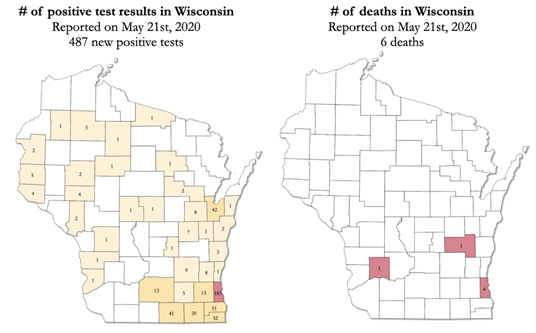
Sources:
- Wisconsin Hospital Association (WHA) COVID-19 Situational Awareness Update site
- DHS COVID-19: County Data; https://www.dhs.wisconsin.gov/covid-19/county.htm
Monday Media Briefing
Wisconsin Governor Tony Evers, Department of Health Services (DHS) Secretary-designee Andrea Palm, DHS Chief Medical Officer Dr. Ryan Westergaard, and Ryan Nilsestuen, Chief Legal Counsel held a briefing for the media today.
Governor Evers noted in his opening remarks that now every county in Wisconsin has reported a case of COVID-19 with Taylor and Langlade county both reporting their 1st cases today. The Governor also requested diligence in continuing to stay “safer-at-home.”
The Governor also discussed his announcement of $100 million in federal funding from the CARES Act being distributed via grants to Long-Term Care, Home and Community Based Services, and Emergency Medical Services. (See more below)
The Governor was asked during the media briefing regarding a new lawsuit that has been filed challenging the local health authorities implementing the “Safer-At-Home” orders. The Governor’s legal counsel stated that they are engaging to have the lawsuit dismissed and believe the interim Attorney General opinion issued by Attorney General Josh Kaul last week provides clarity on the topic. (Link to State Journal story).
The media briefing can be viewed here.
Gov. Evers Announces $100 Million for Long-Term Care, Home and Community Based Services, and Emergency Medical Services
Gov. Tony Evers today announced a grant program funded by the federal Coronavirus Aid, Relief, and Economic Security (CARES) Act. Totaling $100 million dollars, the funding will support providers most at-risk for financial hardship during the COVID-19 pandemic. The providers targeted for financial assistance include emergency medical services, home and community-based services, and long-term care providers such as skilled nursing facilities and assisted living facilities.
“We recognize the significant burden the COVID-19 response has placed on these providers,” said Gov. Evers. “We also recognize the integral role they play in ensuring the health and safety of some of our most vulnerable Wisconsinites and we want to support their efforts during this pandemic.”
The program will be administered in two parts: an initial release of funds to support immediate needs, and a second, targeted release for additional needs of individual providers. Both rounds of funding will be allocated to support expenses directly related to COVID-19 as well as expenses associated with the interruption of typical operations, such as overtime pay, changes to sanitation procedures, and disruption to the standard delivery of care.
Link to press release.
Updated Charts
Daily Numbers:
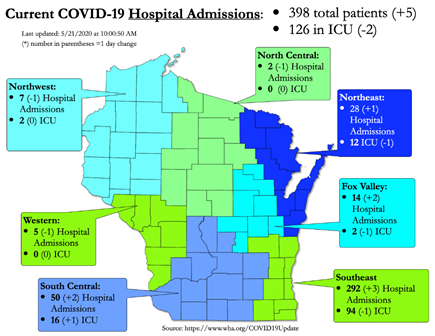
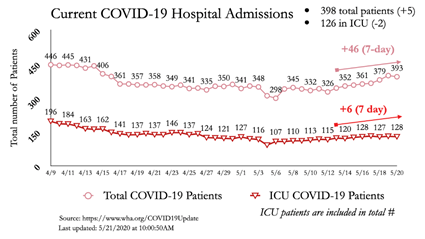
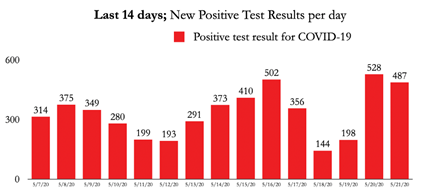
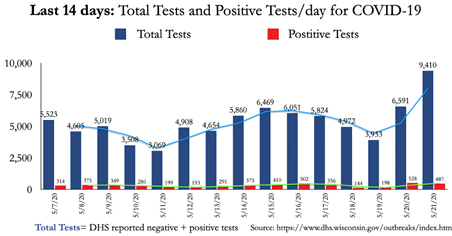
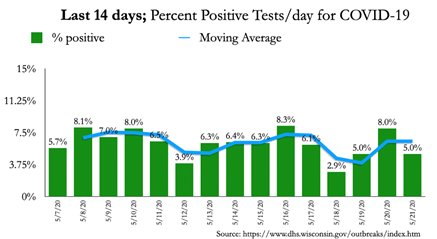
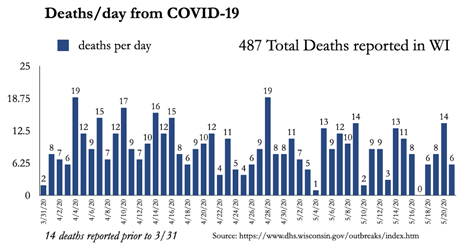
Cumulative Numbers:
